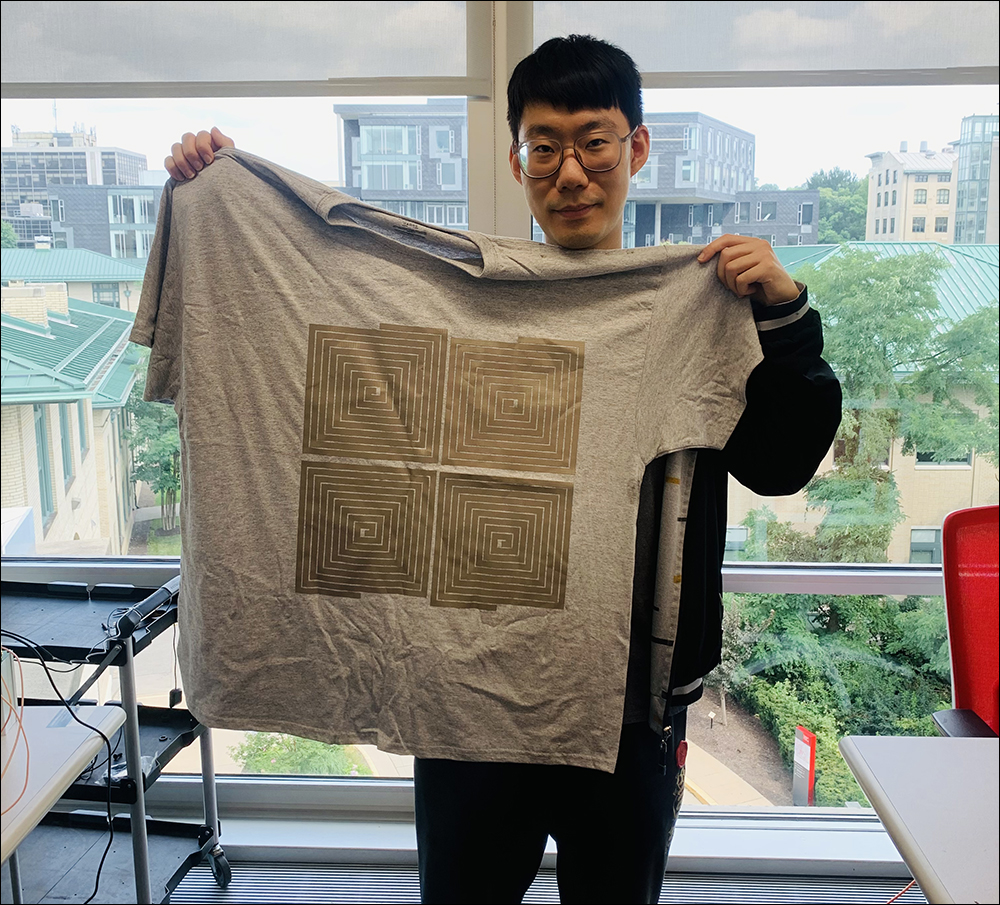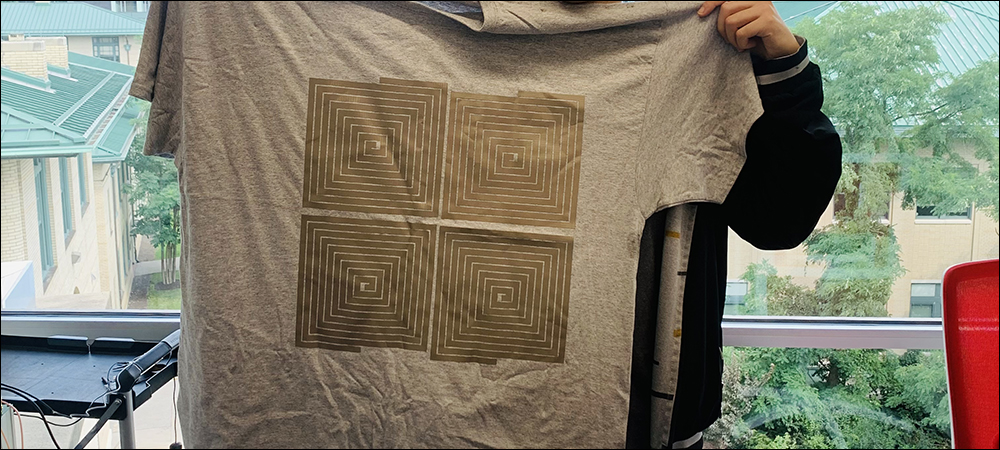Researchers at Carnegie Mellon’s Laboratory for Emerging Wireless Technologies (WiTech) have developed a Near Field Communication (NFC) reading system that features localization capabilities and an extended range, with reader coil antennas that can be woven into textiles to bring connectivity to furniture, clothing or household items. The system was designed to detect and locate the position of NFC tags, but it can also identify movement without requiring an NFC unique identifier, such as the waving of a hand near a reader.
The system could potentially transform furniture into an NFC reader to detect NFC-tagged objects or an individual’s presence and position. The goal of this research was not only to introduce NFC into textile objects, but also to extend the technology’s read distance and enable specific localization. The system leverages a beamforming algorithm that infers a tag’s location, similarly to how a longer-range RFID tag might be located. During lab-based testing, the researchers found its TextileSense technology can pinpoint an object’s location to within about 3.5 centimeters (1.4 inches) at a distance of around 20 centimeters (7.9 inches), according to Junbo Zhang, a Ph.D. student and lead researcher at Carnegie Mellon University.

Junbo Zhang holds up a shirt with woven-in TextileSense reader coil antennas.
The TextileSense system is the third iteration of the solution, and the first that can not only detect an NFC tag but also sense objects made of conductive material, including metal or the human body. Traditional NFC-based systems are not used to locate items, but rather provide short-range reads to enable payments, access control or product authentication, for example. Because the read range is typically only a few centimeters, there is no need to know a tag’s exact location. However, with the solution developed at the WiTechLab, the location of a tag or a conductive material could prompt a specific action, such as turning on lights or enabling gaming.
The system consists of a multiple input-multiple output (MIMO) 13.56 MHz NFC reader compliant with the ISO 14443 standard, along with specially designed antenna coils woven into a textile, such as upholstered furniture, to sense the presence and location of an NFC tag or a non-tagged conductive object. The reader employs “beamforming,” a method that leverages an array of antennas to manipulate the magnetic field distribution, then measure beam signal power response. The signals create an optimal beamforming vector, and a maximum amount of energy is delivered to the object, while the net energy in the system is minimal. The system uses the sum of voltages observed across all coils, with gradient descent techniques.
Some existing systems can accomplish positioning detection based on NFC reader response, such as Microsoft‘s Project Zanzibar. That system is a 2D NFC localization solution, though TextileSense takes the concept a step further by providing a solution with 3D location. The TextileSense reader requires a power source and could be mounted behind the furniture, the research team indicates, so that the flexible antenna coils could be woven into the textile, while the reader would be plugged into the wall behind that furniture.
For non-tagged objects, TextileSense uses a blind near-field beamforming algorithm utilizing the magnetic coupling between an object (a human hand, for instance) and a reader to detect a voltage variation. To enable the system to work with textile materials, the group built the antennas to be bendable, and to be woven into fabric. They worked with material science researchers to fabricate the NFC antenna coils with conductive fabric. Textile coils are both conductive and flexible, the researchers explain, so users can mount the system on irregular surfaces and thereby create a textile-sensing surface even on clothing or a blanket.
The solution opens the opportunity for several applications, Zhang says. TextileSense can identify and track NFC-based objects such as NFC cards or game figurines. If a tagged object is within range of the furniture’s NFC antennas, a system could enable gaming applications in which, for instance, the location of a tagged item could be displayed on a screen as part of a game.
Since the furniture with the NFC reader can also detect the movements of non-tagged items, it could provide solutions based on the movementS of an individual’s hand for gaming applications. The system can detect the location and position of a user seated on an NFC-enabled chair or couch, relying on coupling between the reader and the human body, without requiring NFC tags.
If someone were to misplace a wallet, the system could detect the presence of credit cards and issue an alert to that person, indicating the wallet’s location. Users could also control the volume on a stereo or television by sliding a hand up and down on the surface of the couch where the antennas are integrated.
Since the system could identify posture, it enables solutions to determine if an individual is seated, in which case the lighting would turn on, or lying down, which could prompt the lights to deactivate. It could also detect if a person comes home and sits on a couch, prompting the system to turn on the lights or some other device, such as a PlayStation, automatically. What’s more, if the reader were mounted on a bed and an individual were detected lying down, or if that person waved their hand in a specific manner or direction, the system could turn the lights off.
Users could create settings to instruct the technology to provide specific actions. For example, after deploying the coil on the back of a couch, a user could train the system by measuring transmission response based on voltage measurement and the location of that response. The solution would then be able to detect a familiar motion in the future. If a user had an NFC tag—on a smart watch, for instance—the system could identify that person and require a specific ID to prompt an action. In other words, it could turn on a light for one individual, but not another.
The beam-forming function provides the longer range, Zhang explains. “We use it to expand the range,” he says, by leveraging the focused energy that could be provided by multiple antennas. NFC uses magnetic coupling, whereas far-field RFID employs electromagnetic radiation. “We found that if you put an object at different positions, the voltage measurement would come in different patterns,” This means voltage measurements serve as indicators of the object’s position.
The system still has a few shortcomings, the researchers have found. The transmission does not perform well if there are extreme folds in the fabric into which the coils are woven. Although the solution can localize multiple objects, it cannot distinguish between two tags that are less than 1.5 centimeters apart. Additionally, the cost of the prototype version is high, Zhang says, but that price is likely to drop with the use of commercial NFC readers, phase shifters and other off-the-shelf components.
The group has been working on the system for 18 months and has submitted white papers three times, beginning in December 2019. As the system evolved, the team added localization and longer range, as well as the ability to detect untagged objects. The document was accepted for publication in January of this year.
Looking forward, Zhang says, there is still room for improvement, such as lengthening the read range. Future development, he adds, could further extend the range. “Twenty centimeters is good,” Zhang states, “but maybe we can do better.” He believes further research into security may be important as well, due to the lengthening of the transmission distance, though the existing system has some built-in safety features, including encryption.


